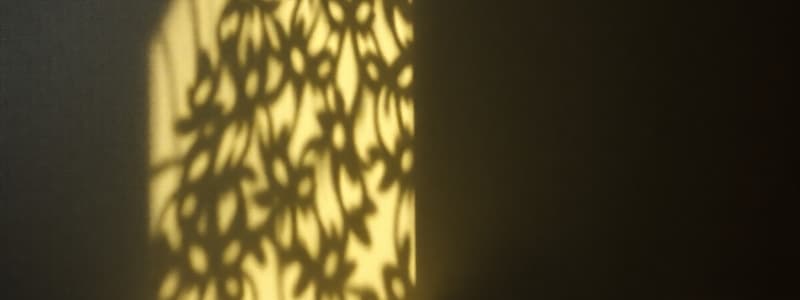Podcast
Questions and Answers
What is the primary reason that shadows are formed?
What is the primary reason that shadows are formed?
- Light travels in straight lines until blocked. (correct)
- Light can bend around objects.
- Shadows only form at night.
- Light reflects off surfaces to create shadows.
What characteristic of a shadow is affected by the size of the light source?
What characteristic of a shadow is affected by the size of the light source?
- The shape of the shadow. (correct)
- The density of the shadow.
- The duration of the shadow.
- The color of the shadow.
Which of the following best describes a non-transparent object in the context of shadow formation?
Which of the following best describes a non-transparent object in the context of shadow formation?
- An object that partially reflects light but lets some pass.
- An object that blocks light completely. (correct)
- An object that diffuses light in multiple directions.
- An object that allows light to pass through entirely.
How does the movement of the sun affect the position of shadows throughout the day?
How does the movement of the sun affect the position of shadows throughout the day?
Why is it important to draw straight lines to represent rays of light?
Why is it important to draw straight lines to represent rays of light?
What determines the size of a shadow cast by an object?
What determines the size of a shadow cast by an object?
Which component of the eye functions similarly to a camera lens?
Which component of the eye functions similarly to a camera lens?
In a dark room setup, what does the semi-translucent page allow you to observe?
In a dark room setup, what does the semi-translucent page allow you to observe?
What is a primary function of light-sensitive cells in the retina?
What is a primary function of light-sensitive cells in the retina?
What happens to shadows as the sun moves across the sky?
What happens to shadows as the sun moves across the sky?
Flashcards
Shadow Formation
Shadow Formation
A shadow occurs when a non-transparent object blocks light.
Path of Light
Path of Light
Light travels in straight lines, creating distinct images.
Inverted Image
Inverted Image
An image that appears upside down due to light optics.
Optical Device
Optical Device
Signup and view all the flashcards
Cornea and Lens
Cornea and Lens
Signup and view all the flashcards
Shadow
Shadow
Signup and view all the flashcards
Non-transparent Object
Non-transparent Object
Signup and view all the flashcards
Light Rays
Light Rays
Signup and view all the flashcards
Shape of Shadow
Shape of Shadow
Signup and view all the flashcards
Movement of the Sun
Movement of the Sun
Signup and view all the flashcards
Study Notes
Activities 3.2: Large and Small Shades
- Shadows change direction and size as the sun moves.
- Animal shadows appear longer depending on the animal's position relative to the sun.
- The size of a shadow changes depending on the position of the light source.
Activities 3.3: Dark Room
- A cardboard box can be used to demonstrate image formation.
- A semi-translucent page is placed inside the box to display an inverted image.
- The image's size, clarity, and position can be adjusted by slightly moving translucent pages within the box.
- The dark room is a simple photographic camera.
- Light rays reflect off objects and are captured by a lens to form an image.
- The lens focuses light onto a film or sensor in the camera.
- The eye works in a similar way, using the lens and cornea to focus light rays onto the retina.
- Light-sensitive cells in the retina transform the light into signals sent to the brain.
Briefing
- A light radius is a straight line representing a light ray.
- A shadow is formed when a non-translucent object blocks light.
Studying That Suits You
Use AI to generate personalized quizzes and flashcards to suit your learning preferences.




